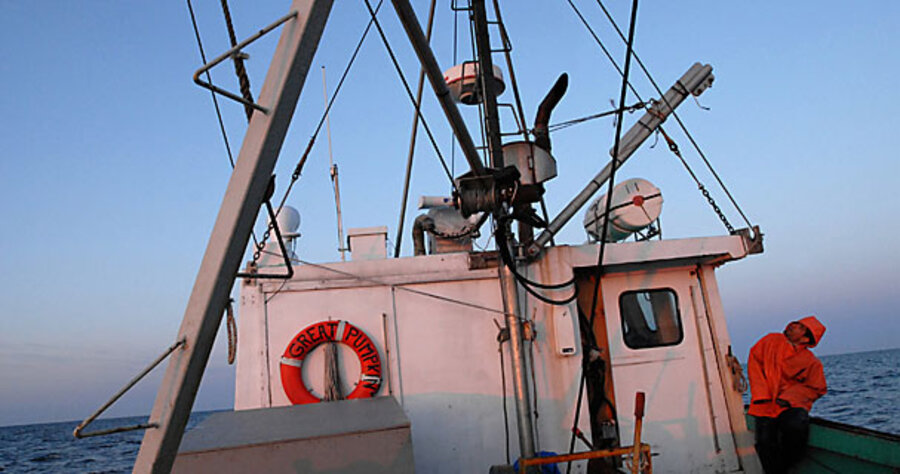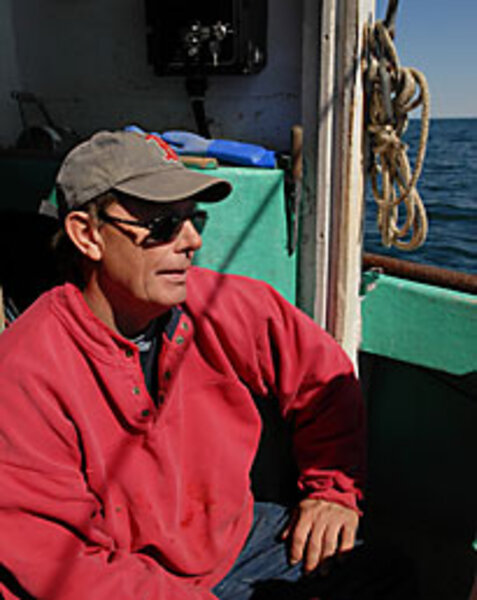Empty oceans, Part 1: Endless no more
Loading...
| HARWICH PORT, MASS.
On a chilly spring morning, Jan Margeson steers his orange-hulled boat, the aptly named Great Pumpkin, into the predawn darkness using radar. Parallel green splotches on a screen indicate the banks of the narrow channel leading out of Saquatucket Harbor to Nantucket Sound. Once in open water, he enters coordinates into a plotter – eight miles due south of Hyannis – and, oriented by GPS satellites, the boat steers itself.
Mr. Margeson has reoutfitted the 41-foot Pumpkin, originally a Nova Scotian lobster boat, for clamming. Margeson, who’s been fishing these waters for 30 years, would rather be fishing for cod. But since stocks of cod crashed in the 1990s, that once-plentiful fish hasn’t recovered. Fishing is now so restricted – only 39 days are allowed this year, monitored via shipboard transmitters – that earning a living solely on cod or other bottom-dwelling fish is difficult. So while he waits for cod to rebound and restrictions to relax, he makes ends meet with clams, or quahogs (KWOH-hogs), as they’re known in the Northeast. “It will help me survive and catch more fish,” he says.
New England fishermen find themselves at a critical transition. Federal law mandates that overfishing end by 2010. With restrictions on fishing tight and no relaxation in sight, many fishermen are selling their permits and getting out. Others are buying them up, to be in good position if and when stocks rebound. The stock crashes have also inspired considerable introspection. Where 25 years ago, fishermen likely espoused an “endless bounty” view of the sea, today they talk about ecosystem health and stress sustainable fishing practices. They’re increasingly concocting – and pushing for – what they say are both fish- and fisherman-friendly solutions. The hunters now emphasize environmental stewardship. Ecological collapse has triggered a cultural shift among fishermen, whom some call “New England’s other endangered charismatic megafauna.”
“There’s been an evolution of ethics. People understand now how dependent they are on the ocean,” says Christopher Brown, head of the Rhode Island Commercial Fishermen’s Association. “I am nothing more than another critter. How can I be any healthier than the health of the ecosystem I depend on?”
Cod has long been regarded as a resilient fish. It rebounded quickly after the foreign factory trawlers were expelled from the US’s newly established 200-mile Exclusive Economic Zone in 1976. By 1982, the Georges Bank commercial cod harvest had reached 57,000 metric tons, some 19.4 million fish.
But by the early ’90s, cod had begun to decline again. In 1980, researchers estimated the combined weight of all spawning cod at 93,000 tons. In 1995, it sank to a record low of 17,340 tons.
More than a decade later, large areas of Georges Bank remain closed and although some overfishing of cod still occurs, cod fishing has been greatly curtailed. But the cod haven’t come back, and no one quite knows why.
Scientists suspect that other species, which are now relatively abundant, may be preying on young cod. Fishermen blame dogfish, a kind of shark, although scientists say dogfish don’t eat cod. But scientists and fisherman do agree on one thing: “It was overfished,” says Margeson. And much of the fault lies with fishermen, he says.
As the sun rises over Nantucket Sound, Margeson explains: When cod seemed limitless, economic gain trumped sustainable practices. Fishermen raced to catch as many cod as quickly as they could. And regulations, when they finally came, only made things worse. Efforts to try to limit fishermen’s behavior failed. The ever-dwindling number of days one was allowed to fish encouraged practices that were not only environmentally costly but also unsafe. Limits on how much could be landed on a single trip – currently 1,000 pounds for cod – meant that fishermen who’d netted more might throw back thousands of pounds of dead, but otherwise perfectly good, fish.
“The discard issue was huge,” Margeson says. And the waste further depressed stocks. “We all knew that something had to be done,” he says. Survival rates for discarded net-caught fish are very low.
In 1991, Margeson and other Cape Cod fishermen formed the Cape Cod Commercial Hook Fishermen’s Association (CCCHFA). The idea: to go easier on fish habitat by using fishing technology – like hooks – that didn’t damage the sea floor. (Hook-caught fish also means fewer discards, as fishermen can stop when the limit is reached.) More recently, the group pioneered an approach to fishery management inspired by quota systems in places like New Zealand and Alaska.
In 2004, a group of CCCHFA fishermen asked to be assigned a percentage of the year’s total allowable cod catch. (Scientists recommend what should be caught in a given year.) The new approach did away with the hated trip limits and time constraints that encouraged a wasteful and unsafe “race to fish.” Members could harvest at leisure, take advantage of favorable market prices and take the time necessary for low-impact fishing practices.
In theory, the approach also encourages conservation. If fishermen fish sustainably, fish become more numerous, and the value of a fisherman’s allocation grows.
“The quota system is a good way to regulate fish, a good way to regulate fishermen,” says Margeson.
Two years ago, another such arrangement was approved for CCCHFA fishermen using fixed gear (gill nets, longlines). And the idea is catching on. This year, New England fishermen proposed 17 such “sectors.” Many say this grass-roots effort is a milestone in a region where fishermen have historically opposed hard limits on how much they can catch.
“Things are changing with breathless speed, far more rapidly than I thought they ever could,” says David Preble, a retired fisherman and member of the New England Fishery Management Council. “I thought it would take us a decade, but it’s happening very, very quickly.”
Several on-the-ground facts are driving the change: Congress’s newly reauthorized Magnuson-Stevens Fishery Conservation and Management Act says that if overfishing does not end by 2010, regional fishery management councils will lose their authority. The feds will step in. “We’re on the clock,” says Steve Murawski, chief scientist of the National Oceanic and Atmospheric Administration (NOAA) Fisheries in Silver Spring, Md. “The law says we have to end overfishing.”
New England has 800 to 900 active federal ground fish permits. (Ground fish swim close to the bottom and include pollock, haddock, and cod.) To achieve economic viability and ecological sustainability, some say the fleet must shrink by as much as two-thirds. The implied dissolution of the few fishing communities that remain weighs heavily on fishermen who, besides showing an almost religious devotion to their profession, can earn six-figure salaries. Many are scrambling to find ways for the same number of fishermen to make a living off fewer fish.
In Port Clyde, Maine, the two-year-old Midcoast Fishermen’s Co-op has sought to brand its catch as environmentally friendly and charge more for it. By selling fewer fish for more money, the group hopes to maintain the fishing community.
Farther east along the Maine coast, where fish stocks are badly depleted and 90 percent of the fishermen now rely on lobster, the Penobscot East Resource Center’s Downeast Initiative is pushing for “community-based management.” The idea is that because communities closest to fishing areas have the greatest stake in their viability and know them best, they should set management rules.
“All ecology is local. Fish live in, return to, and feed in specific places,” says Robin Alden, the center’s executive director. “It’s only through taking care of specific areas that you can take care of fish populations.”
And CCCHFA hopes to thwart an unintended effect of fishing rights becoming sellable. To keep permits from migrating out of the local community, CCCHFA will buy up permits and then lease them based on certain criteria – living locally, owning a boat, paying deckhands a share of the catch, say – that foster what Paul Parker, executive director of CCCHFA, calls the “triple bottom line” of economic, social, and ecological goals. “We maintain our sense of place,” he says. It’s a good way for us to continue a way of life.”
For his part, Margeson is determined to weather this transition, see the stocks rebound, and keep fishing. “I’m too old for a career change,” he says. And besides, he enjoys it. “I love it for the freedom,” he says.
The fact that fishermen have less freedom today is not lost on Margeson. Since the mid-1990s, gradually tightening regulations have done away with the notion that the ocean is a wild, unregulated frontier. And now, as New England fishermen form associations to weather hard times and overhaul their industry, they must give up more of that independence. Where autonomy was once prized, collaboration is now emphasized.
[Editor's note: The original story omitted Paul Parker's first name and attribution. The story also carried a headline and subhead that did not adequately characterize the story's content. A photo caption in the original was rewritten to clarify the fact that Jan Margeson owns two fishing boats. The video accompanying this story originally misstated the number of days allowed to fish for cod. Additionally, a previous version of this correction misspelled Jan Margeson's name.]
Empty Oceans, a series on the state of the world's fisheries, will be appearing in the Monitor's environment section. For the full series, click here.






